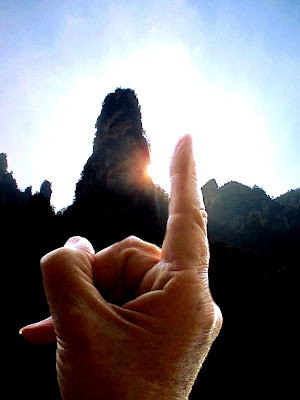 |
| the view from down below |
 |
| the monorail train |
After a trip to the long
distance bus terminal to get information on buses to Fenghuang (the next stop on our itinerary 236 km south of Zhangjiajie) we
returned to Wulingyuan Park to take the monorail train to
a different area of the park from yesterday's cable car.
While
looking for a taxi in front of our hotel and old van rumbled by in
front of us, abruptly stopped and backed up in front of us. There was
a man driving and a woman and young girl sitting in the back seat leaving
the middle seats empty. The man offered to give us a ride so I asked "how much?" in my best Chinese (duō
shǎo qián).
It must have sounded right because he showed
me one finger (1 yuan). So we jumped in the car and bowed and smiled at
the family.
We
rather naively thought that 1 yuan was rather cheap so I offered him
a 10 yuan note (about $1.45) when we finally arrived at the Eastern Gate after a
rather circuitous route getting there. (We knew the town well enough by now to know that we were being taken for a ride.) Instead of
happily taking the 10 yuan note, he showed me two fingers with one hand and pointedly pointed at the 10 yuan note with the other. Conned again! The taxi fare to the park is only 10 yuan. The
woman and girl were half smirking and half giggling in the back seat and I almost
laughed myself and gave the dude his 20 yuan. Oh well, the family
looked rather needy so we chalked it up to charity and another lesson
in being conned when you aren't alert.
 |
nice views from the monorail train,
riverbed (not visible) on the left |
The
park entrance wasn't crowded and since it was later in the day and
we already had a 4-day pass we didn't have to by a ticket and proceeded
directly to the entrance gate and soon got a bus to the monorail
stop. The monorail is about 1.7 km long near a river bed and, consequently is lower than the high vantage views from the summit of the previous day's cable car. The scenery from the train looked more interesting than yesterday's. Towering tree-crowned
hoodoos blossoming all around.
 |
| monorail and parallel footpath |
 |
| at the monorail terminus |
After
getting off the little green and white train we walked a little farther along a paved trail before returning to the monorail terminal and,
instead of riding back, walked down a footpath that parallels the
monorail track. Some interesting rock formations along the path
included an “Old Man Gathering Herbs” and a “Forefinger”
nicely back-lit by the afternoon sun. A couple wild monkeys performed
their antics with oranges tossed to them for the entertainment of
their descendants.
 We
made our third excursion into the Wulingyuan Park by taxi to the
eastern entrance, a real taxi for 10 yuan. Being a Monday the weekend
crowds had thinned out—there was only one group tour when we went
through the gate. We were getting used to the routine of taking the
park buses and getting to a desired destination by pointing it out to the bus driver on the map and getting a nod.
We
made our third excursion into the Wulingyuan Park by taxi to the
eastern entrance, a real taxi for 10 yuan. Being a Monday the weekend
crowds had thinned out—there was only one group tour when we went
through the gate. We were getting used to the routine of taking the
park buses and getting to a desired destination by pointing it out to the bus driver on the map and getting a nod.
 After
getting off the elevator on the mesa top a road leads to
another bus stop that takes you to a spectacular paved walking path along
the cliff top with great views of various sized hoodoos, deep canyons
and cliffs eroded by eons of weathering.
After
getting off the elevator on the mesa top a road leads to
another bus stop that takes you to a spectacular paved walking path along
the cliff top with great views of various sized hoodoos, deep canyons
and cliffs eroded by eons of weathering.

 I am
particularly fascinated by monkeys since they often behave in ways
that resemble human behavior. It was a big treat for me, therefore,
to see lots of wild monkeys that make their home in the park and are
accustomed to getting food from people eager to feed them—or
stealing food from others not so eager to feed them. One particularly
aggressive male ripped off a bag of oranges from a young woman who was
taking photos of her boyfriend while said monkey put on quite a show
struggling to get the peel off one particularly stubborn orange while
giving me the evil eye.
I am
particularly fascinated by monkeys since they often behave in ways
that resemble human behavior. It was a big treat for me, therefore,
to see lots of wild monkeys that make their home in the park and are
accustomed to getting food from people eager to feed them—or
stealing food from others not so eager to feed them. One particularly
aggressive male ripped off a bag of oranges from a young woman who was
taking photos of her boyfriend while said monkey put on quite a show
struggling to get the peel off one particularly stubborn orange while
giving me the evil eye.
























































